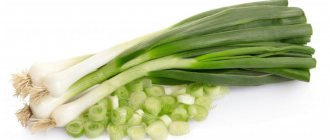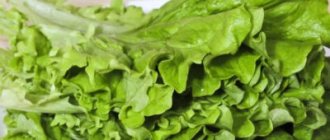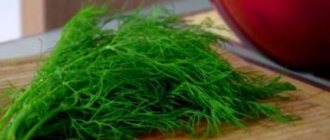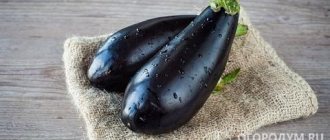Spinach is a real storehouse of nutrients. It is a leader among leafy vegetables in terms of vitamins and microelements. The plant is very popular all over the world; it is eaten both fresh and processed. You can find delicious leaves on the shelves of many supermarkets all year round, but given their cost in the off-season, it is better to freeze spinach for the winter yourself, especially if it grows in large quantities in the country or near the house.
When purchasing bunches of fresh leaves at the market, you need to choose strong, bright greens with elastic petioles
Selection and preparation of leaves
Before freezing, pickling or drying (in any case), use young leaves - no more than 8 cm. It is very important to harvest before flowering begins. The benefit lies in the young leaves.
Blooming spinach becomes bitter, fibrous and completely tasteless. Oxalic acid accumulates in it. It cannot be used for freezing.
How to Freeze Raw Spinach
Regardless of the method chosen, the greens are always pre-washed, sorted and dried. You need to wash it in running water at least 4-5 times, very carefully, since there is always a lot of dust and fine sand on the leaves. All crumpled and withered leaves must be removed.
After drying, sorting begins. You can dry it simply by waiting for the water to drain or pat it dry with a cotton towel. Excess moisture on the leaves in the freezer will turn into ice and the taste will be affected.
For freezing, whole, medium-sized leaves are selected, the stems are torn off, but not thrown away. They are used for purees. Place whole leaves of approximately the same size in stacks of 10–15 pieces - these are single servings. Without damaging the integrity, roll them tightly into rolls and secure with cling film, place on a tray and place in the freezer. Once completely frozen, transfer to containers for long-term storage. If necessary, you can cut pieces of the desired size from the roll.
How to Freeze Spinach Leaves
Very often, frozen spinach from the store comes in bags in the form of balls or sticks. This shape can be created at home with ice cube trays.
First, you need to select the spinach leaves and wash them thoroughly. Cut into long strips. The water should drain completely. After this, press the spinach strips into sticks and put them in freezer bags.
Pros of dry freezing:
- simplicity and low labor intensity of the method;
- The leaves are frozen raw and contain more vitamins and minerals.
Minuses:
- sausages need space in the freezer;
- Leaf color is not preserved.
Blanched spinach
The leaves can be whole or chopped, but previously blanched. To do this, you need to use 2 pans at the same time: one with cold water and crushed ice and the second with boiling water.
You can add a pinch of soda to boiling water to preserve the color of the greens.
Place the spinach in small portions in a sieve or colander into boiling water for 15–20 seconds. Quickly remove and immediately immerse in ice water for 15-20 seconds. It is necessary to let the water drain and transfer to stretched gauze.
The leaves should be crumpled well in your fist. Place the finished lump on a film or silicone mat. Then place in the freezer for 4 hours to freeze the top layers.
The balls are frozen, then portioned into containers or bags. Store in the vegetable compartment.
Advantages:
- the workpieces are compact;
- the product is ready for use immediately;
- natural color is preserved.
The big disadvantage is that blanching destroys some of the vitamins.
Spinach puree
Spinach bunches and stems are used for puree. Everything goes through a blender and is brought to a homogeneous mass. If there is no blender, the mass is rubbed through a sieve. Place the resulting puree into small silicone molds.
In the freezer, the puree will freeze in a few hours. The solid cubes are removed from the molds, placed in a bag and placed back in the freezer for long-term storage. With this method of preparation, color and all vitamins are preserved.
Chopped spinach
Greens with this storage method should be cut into small pieces. Preliminary preparation of leaves is normal.
On an unfolded square of cling film, place the greens in the center and carefully roll them into a tight sausage. Press down on both sides like candy, put a leaf with an inscription on it so as not to confuse it with other greens.
You can store spinach in the freezer for 10–12 months. When cutting the desired piece, the cut is wrapped in a piece of film.
Freezing in ice cubes
Preliminary procedures for washing and drying are standard.
Next, the leaves are cut into medium-sized pieces, placed in low containers or ice trays and filled with boiled water. The water should cover the greens completely. The forms are placed in the freezer for initial freezing. Pouring water preserves all the juice and color of the spinach. Vitamins are also preserved better with this method.
Preliminary work
For freezing, it is best to choose spinach leaves from the very first harvest ; they have a delicate consistency and do not have a bitter aftertaste, unlike leaves collected after the formation of flower shoots.
It doesn’t matter which freezing method is chosen, the greens must be thoroughly washed to remove soil and sand. This can be done by lowering bunches of greenery into a deep container with cold water, and then removing them and thoroughly rinsing each leaf under running water.
All yellowed and wilted leaves must be removed. If the freezing method is used, without blanching, the greens must be dried so that when exposed to low temperatures, excess moisture does not turn into excess, unnecessary ice.
How to freeze spinach after cooking
Preliminary preparations of leaves are usual, as for any greens. Cooking may involve blanching or cooking before freezing. Next, the leaves are dried, allowed to drain and placed in bags.
Freezing Boiled Spinach Leaves
Not everyone likes to eat spinach fresh. When heat treated, it reveals its taste better.
Boiled spinach leaves, cut into medium pieces, are formed into lumps and placed in bags. They are stored in the freezer and do not require pre-treatment when used.
Freezing spinach puree
Recipe:
- wash the leaves, trim them, cut them into small pieces;
- boil in lightly salted water for 5–6 minutes;
- place in a colander and allow excess liquid to drain;
- grind the mass into puree and boil;
- Readiness is checked by thickness - the puree should not flow from the spoon.
The finished mass is distributed into jars and placed in the refrigerator.
Freezing puree with butter
The puree is prepared according to the method described above. But at the stage of transferring the mass into ice molds, it is filled with melted and slightly cooled butter.
Spinach should be stored in a bag or tray and added to your favorite dishes 3-4 minutes before it is ready.
If these are boiled leaves
Is it possible to freeze not only raw, but also pre-blanched leaves? Yes, you can. The method involves the following steps:
- Place the spinach in boiling water for twenty to thirty seconds;
- then transfer it to ice water;
- remove, let the liquid drain, form small balls from the leaves;
- portion into bags or containers and place in the freezer.
The method is designed to store spinach throughout the year . At the same time, it will not deteriorate and will retain all its benefits.
Shelf life of frozen spinach
When properly frozen, using small portioned sealed containers with tight lids, greens retain all their properties in the freezer.
Spinach storage temperature should remain the same. Partial defrosting cannot be used either. This will cause the spinach to spoil very quickly.
Many people are concerned about the issue of re-freezing. Double freezing is excluded. With any method, spinach retains its properties for 10–12 months. It is advisable to label the bags.
The only exception is spinach puree with butter. It is not stored for more than 2 months.
Smoothie
Smoothies with frozen greens are prepared using water, juices, as well as yogurt and kefir. To prepare it, it is best to use cubes frozen in ice cube trays. Place the chopped cubes in a blender bowl, add liquid, add other ingredients, and blend. Drink this delicious, healthy, dietary drink for your health!
It's time to say goodbye, but not for long. Tomorrow I will try to please you, my dear readers, with a recipe for lush apple charlotte - “White filling” has been worse than ever for us this year.
I look forward to your comments with joy and impatience. I would be grateful if you send my notes to social networks. Bye everyone and all the best!
Always yours Irina.
It is extremely pleasant that such a bewitching melody bears my name. I adore the sea - after all, I was born on the bluest sea in the world. I love hugs - they speak about love better than any words.
Gary Ayvazian – “Irina” / Michael & Inessa Garmash – paintings
How to Store Fresh Spinach in the Refrigerator
Spinach is a very tender plant and can be stored at room temperature for up to 2 days; it quickly loses moisture, withers and spoils. For longer storage, you can store the leaves in a covered enamel pan in a closet, for example.
In the refrigerator it should be stored in the vegetable drawer. Another way: sort out the leaves, wash them and place them in a layer in a tray, cover with ice water.
The container should be stored on a shelf with the lowest positive temperature, and the water should be changed every day. This will preserve the vegetable for a week. To increase the shelf life in the refrigerator to a month, you should wrap the greens in cling film or plastic bags. The package should have small holes made with a fork or toothpick in several places. This will prevent the juiciness from escaping.
Other methods include salting and canning. When salting, the shelf life increases significantly. Leaf preparation is normal. But after drying, the leaves are placed in glass jars in layers, sprinkled with salt (100 g of salt per 1 kg of greens).
Or you can pour all the leaves into a bowl with salt and mix everything. You need to put them in jars quickly so that the juice does not escape. When the greens have settled, put them in the refrigerator. This preparation is stored until the new harvest.
Cooking steps
step 1 First of all, let's prepare our main ingredient for freezing for the winter - spinach. You can safely regulate its quantity yourself: you can freeze one bunch or a dozen at once for testing.
Step 2 First, we get rid of all compactions and too hard stems. After this, carefully rinse the leaves under running water. Dust, dirt and sand can easily get into the recesses, and we also need to get rid of them. Therefore, give this process maximum of your attention and patience.
Step 3 Let the spinach leaves dry, then chop the spinach with a sharp knife into very fine strips as shown in the photo. After this, there are two options for subsequent actions: blanching or direct freezing. Blanching is used mainly to reduce the volume of the harvested product, but if you want to freeze a couple of bunches of spinach for the winter, then it is simply not necessary. To blanch, you need to bring the water in a saucepan to a boil and literally lower the spinach into it for 2-3 minutes. Then you need to form, or rather, roll neat balls from the spinach treated with boiling water and squeeze the water out of them. Such balls must be lightly frozen in the refrigerator and only then packed into bags.
step 4 If you still decide not to blanch the spinach, then put the shredded strips into prepared clean and dry bags, carefully remove the air inside them, and then seal them. We mark the preparations and send them to the freezer.
step 5 Spinach frozen at home for the winter is ready, you can defrost it at any time and cook something tasty and fresh.
Bon appetit!











